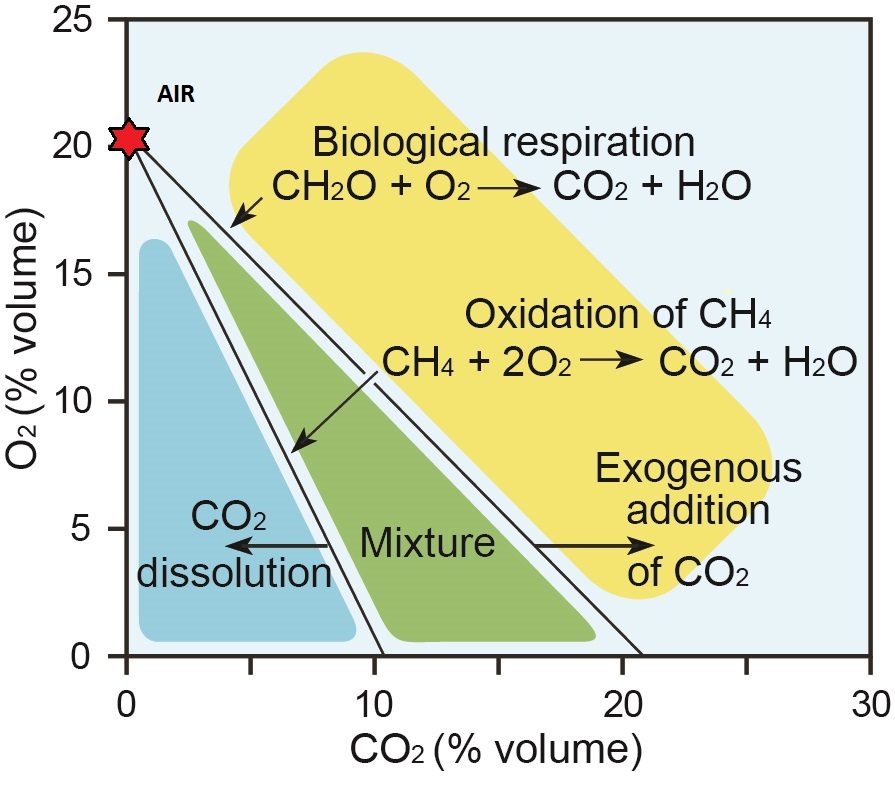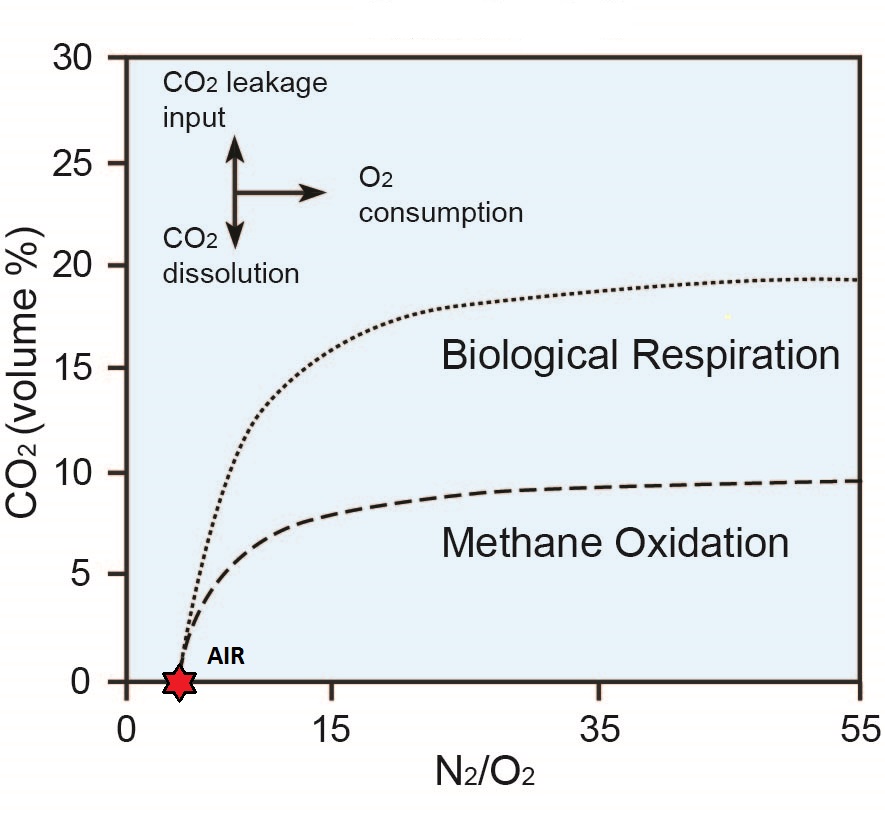Process-Based Environmental Monitoring at CO2 Storage Sites
Real-time attribution of CO2 found in soils, whether from natural or induced environmental changes
Principal Investigator: Katherine Romanak
Keynote
Historically, monitoring for carbon dioxide (CO2) at the ground surface above carbon storage sites required years of baseline data. With the urgent need to abate emissions, many projects do not have the time required to gather this data or it is simply unavailable. To bypass this dilemma and improve accuracy, a method to detect CO2 and its origin in real time was developed.
By measuring multiple gas concentrations within the subsurface soil, the relative changes between CO2 and other gases can give a clue to the origin of the CO2.
This newly developed approach examines chemical relationships between vadose zone—the ground above natural drinking water— N2, O2, CO2, and CH4 to promptly distinguish between a leakage signal and CO2 fluctuations due to natural processes like biological respiration.
As stated in the pioneering paper, the method uses sequential inspection of the following gas concentration ratios and their signal:
- O2 versus CO2 to distinguish in‐situ vadose zone background processes (biologic respiration, methane oxidation, and CO2 dissolution) from exogenous deep leakage input,
- CO2 versus N2 to further distinguish dissolution of CO2 from exogenous deep leakage input, and
- CO2 versus N2/O2 to assess the degree of respiration, CH4 oxidation and atmospheric mixing/dilution occurring in the system.

 |
|

|
These gases vary predictably with natural and induced environmental changes—the changes indicative of whether or not a leak is detected. This relatively simple tool for incident response by fingerprinting anomalies is cost-effective, accurate, and can be used in areas lacking background data. As part of the IPAC-CO2 Kerr investigation (2010–2011), this method was used to successfully attribute a CO2 anomaly garnering leak allegations, ruling out CO2 contamination. Download a presentation detailing the investigation here.
The traditional challenges facing this environmental monitoring and the benefits of the new technique are described below.
Challenges of concentration-based monitoring
- 1–3 years cannot capture the full variation in natural CO2.
- Background measurements time, cost, and labor intensive.
- Leakage signals smaller than natural variability may be overlooked
- Background concentrations cannot be measured everywhere within the area of review.
- An incident can occur in an area with no background monitoring.
Benefits of process-based soil gas method
- Does not rely on background CO2 measurements
- Uses ratios among major gases (CO2, CH4, N2, O2)
- Discerns process
- In-situ from exogenous gas
- Mixing with air
- CO2 dissolution
- Oxidation of CH4 into CO2 (important for CO2-EOR site monitoring)
- Being developed for groundwater and marine environments
Publications
Anderson, J.S., Romanak, K.D., Yang, C., Lu, J., Hovorka, S.D., and Young, M.H. 2017. Gas source attribution techniques for assessing leakage at geologic CO2 storage sites: Evaluating a CO2 and CH4 soil gas anomaly at the Cranfield CO2-EOR site. Chemical Geology, 454 (93-104). https://doi.org/10.1016/j.chemgeo.2017.02.024.
Romanak, K.D., and Bomse, D.S. 2020. Field assessment of sensor technology for environmental monitoring using a process-based soil gas method at geologic CO2 storage sites. International Journal of Greenhouse Gas Control, 96. https://doi.org/10.1016/j.ijggc.2020.103003.
Romanak, K.D., Bennett, P.C., Yang, C., and Hovorka, S.D. 2012. Process‐based approach to CO2 leakage detection by vadose zone gas monitoring at geologic CO2 storage sites. Geophysical Research Letters, 39 (15). https://doi.org/10.1029/2012GL052426.
Romanak, K.D., Sherk, G.W., Hovorka, S.D., Yang, C. 2013. Assessment of Alleged CO2 Leakage at the Kerr Farm using a Simple Process-based Soil Gas Technique: Implications for Carbon Capture, Utilization, and Storage (CCUS) Monitoring. Energy Procedia, 37 (4242-4248). https://doi.org/10.1016/j.egypro.2013.06.326.
Romanak, K.D., Womack, G.L., Bomse, D.S. 2014. Field Test of in Situ Sensor Technology for Process-based Soil Gas Monitoring. Energy Procedia, 63 (4027-4030). https://doi.org/10.1016/j.egypro.2014.11.433.
Romanak, K.D., Yang, C., and Darvari, R. 2017. Towards a Method for Leakage Quantification and Remediation Monitoring in the Near-surface at Terrestrial CO2 Geologic Storage Sites. Energy Procedia, 114 (3855-3862). https://doi.org/10.1016/j.egypro.2017.03.1517.
Sherk, G.W., Romanak, K.D., Dale, J., Gilfillan, S.M.V., Haszeldine, R.S., Ringler, E.S., Wolaver, B.D. and Yang, C. 2011. The Kerr investigation: Findings of the investigation into the impact of CO2 on the Kerr property, final report. IPAC-CO2 Inc., Regina, Saskatchewan, Canada.
Yang, C., Romanak, K., Hovorka, S. D., Holt, R. M., Lindner, J., & Trevino, R. 2013. Near-Surface Monitoring of Large-Volume CO2 Injection at Cranfield: Early Field Test of SECARB Phase III. Society of Petroleum Engineers. https://doi.org/10.2118/163075-PA.
Yang, C., Romanak, K.D., Reedy, R.C. et al. 2017. Soil gas dynamics monitoring at a CO2-EOR site for leakage detection. Geomech. Geophys. Geo-energ. Geo-resour. 3, 351–364. https://doi.org/10.1007/s40948-017-0053-7.
Patents
Process-based approach for the detection of CO2 injectate leakage
https://patents.google.com/patent/US9816972B2/en
Process-based approach for the detection of deep gas invading the surface
https://patents.google.com/patent/US9645129B2/en
Gas sensor to enhance implementation of a process-based leakage monitoring method
https://patents.google.com/patent/US20160202186A1/en
This work was funded by the U.S. Department of Energy through the Office of the Governor of Texas (contract DE‐FG04‐9OAL65847) and the National Energy Technology Laboratory (contract DE FG26‐05NT42590) through the Southeast Regional Carbon Sequestration Partnership.
Last Updated: July 16, 2020



